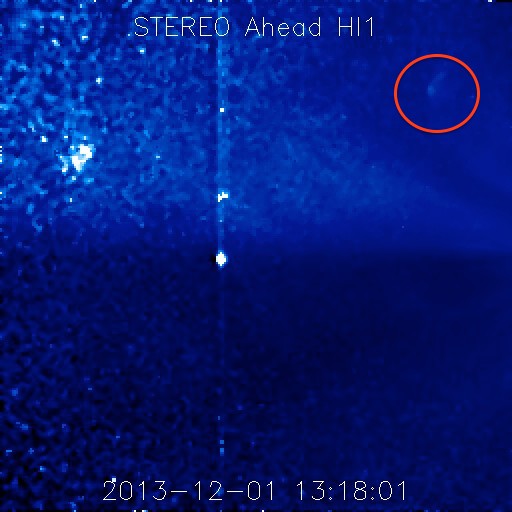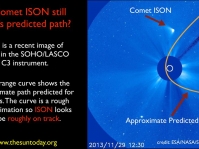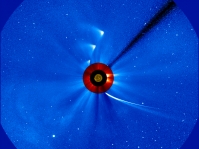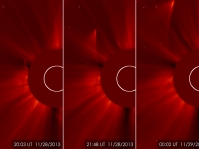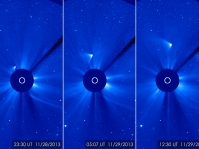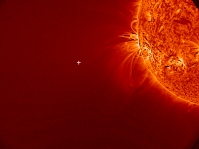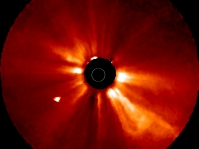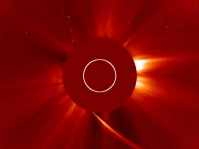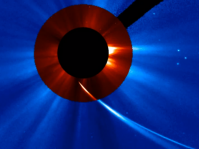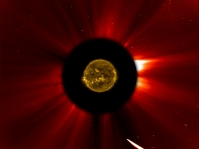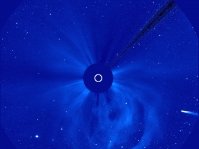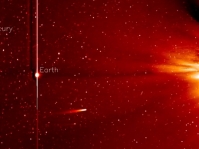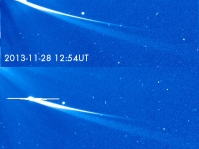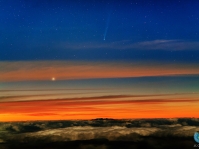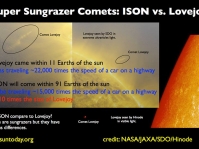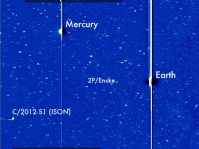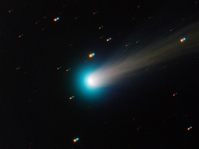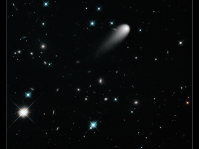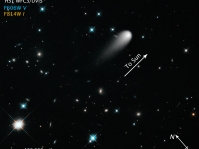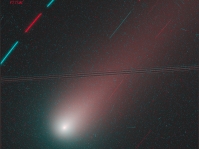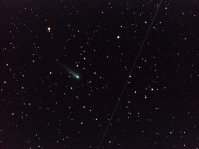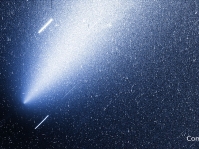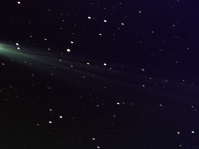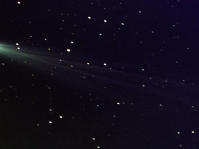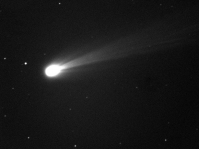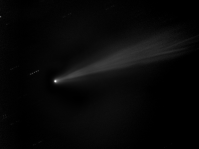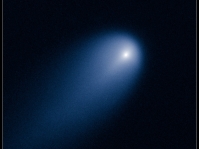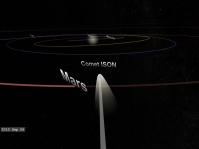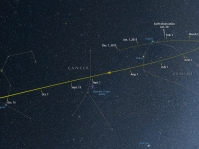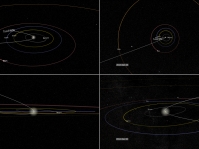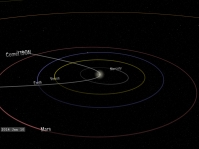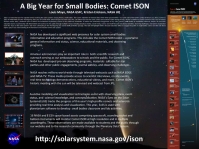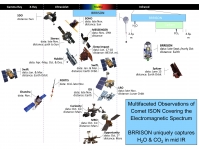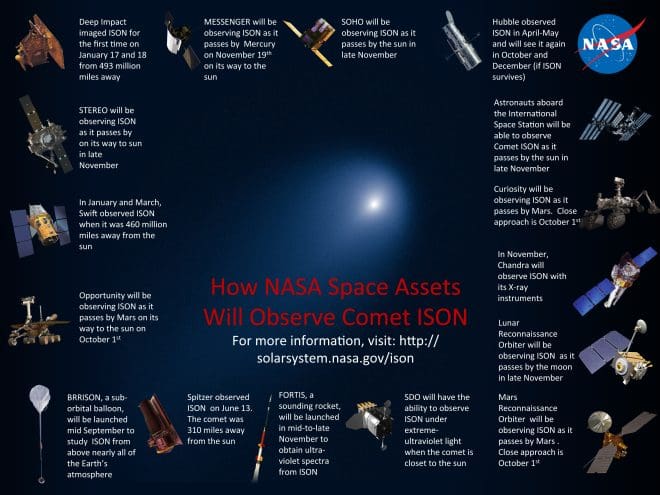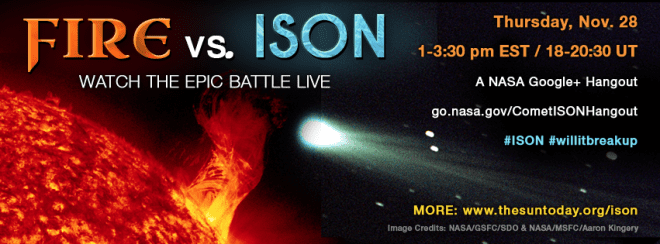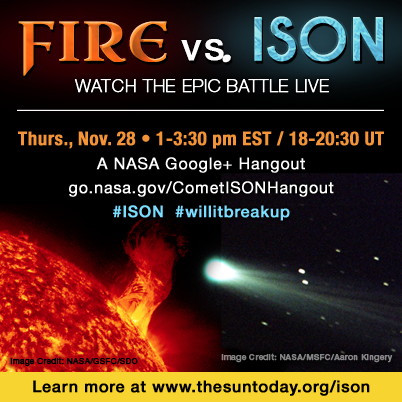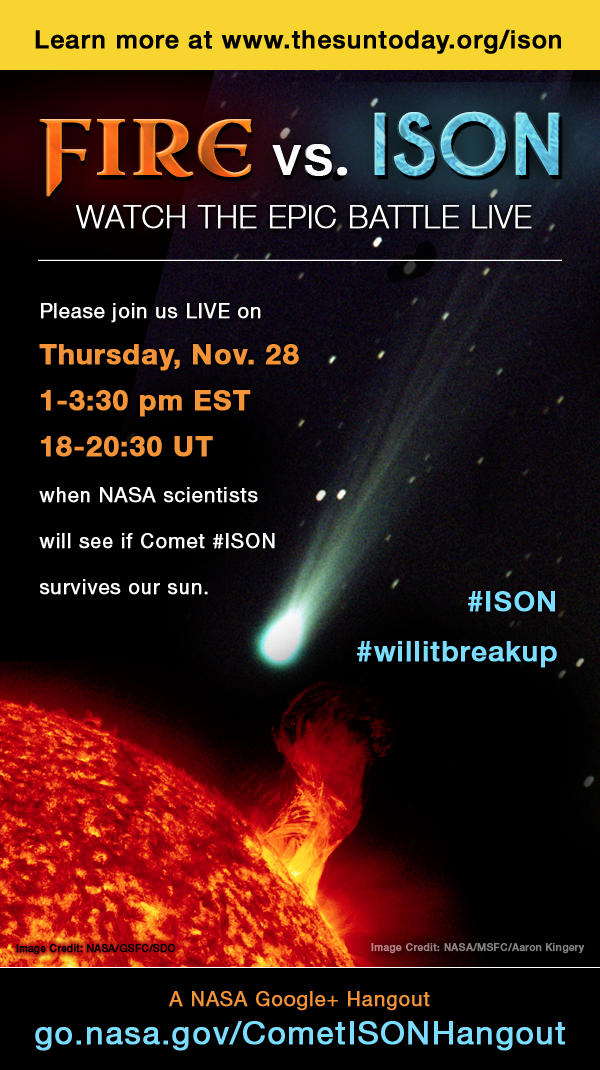UPDATE – 12.02.13 – The Complete Journey of Comet ISON Past the Sun in the STEREO COR2 Instruments
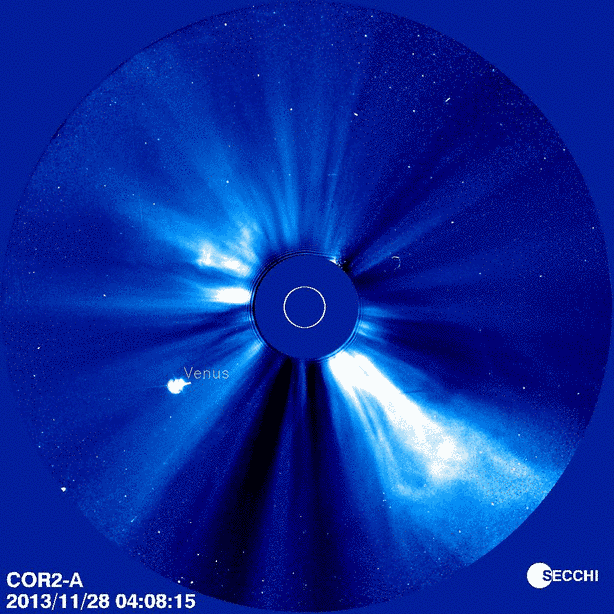
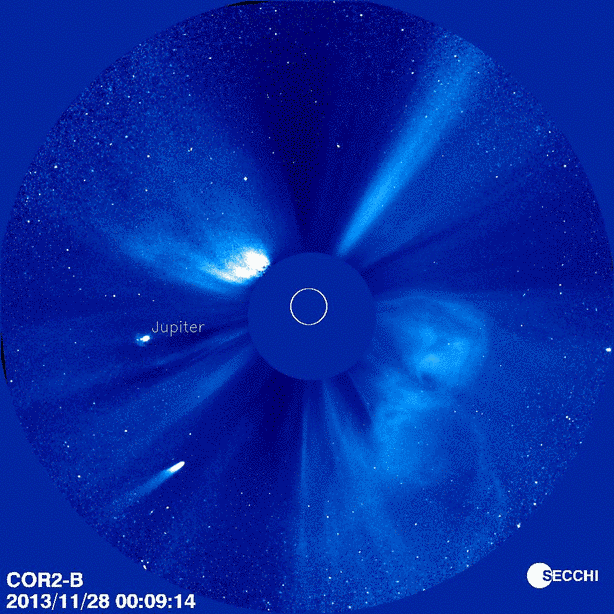
UPDATE – 12.01.13 – ISON Remnants in STEREO HI1 Ahead
Here is an image of Comet ISON’s leftovers that are visible in the STEREO Ahead spacecraft’s, Heliospheric Imager 1 (HI1). This data is from the beacon data, which is intended to be available as quickly as possible for space weather events. Because STEREO is so far away we can only get a subset of the data at this lower quality quickly. This means the data does not look great. We have to wait a couple of days before we can download the complete, high quality data. The full quality data for this event should be available around December 4-5. We have better contact with STEREO Ahead than we are STEREO Behind because of their locations.
UPDATE – 11.30.13 – ISON Fading Away?
Karl Battams of the Naval Research Laboratory and the NASA Comet ISON Observing Campaign (CIOC) provided his most recent assessment via Twitter today – “I *do* think that something emerged from the Sun, but probably a v.small nucleus or “rubble pile”, and I fear that may have now dissolved…”
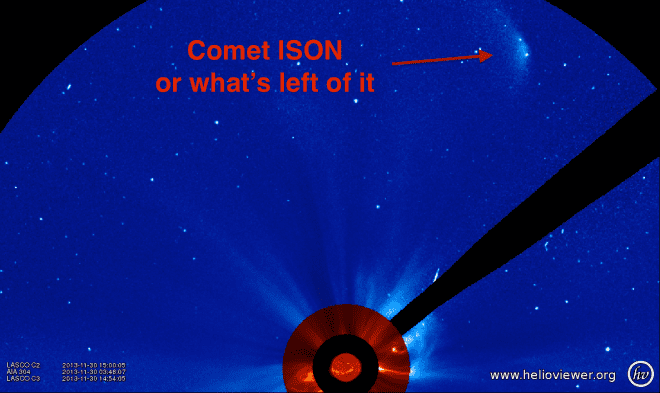
The most recent image of Comet ISON from SOHO/LASCO C3 at of 14:45 UT, 11/20/2013. This is perhaps the final bit of ISON.
Here is a great montage of ISON from Damian Peach.
UPDATE – 11.29.13 – Why didn’t SDO see Comet ISON?
We were all disappointed that SDO did not observe the comet. We expected that it would based on Lovejoy and N3 in 2011. Dean Pesnell, the Project Scientist for SDO provides his thoughts about this at the SDO blog in Where Was Comet ISON? Dan Seaton of the PROBA2/SWAP instrument from ESA provides his thoughts about why SWAP didn’t see ISON. SWAP saw Lovejoy along with SDO and the instrument is similar to the 171 Angstrom wavelength camera of SDO.
UPDATE – 11.28.13 – ISON Still Lives?
We all thought that Comet ISON was done. After some new analysis comet experts are feeling confident that there is at least a small nucleus intact. Their initial analysis indicates that it is still behaving like a comet. An extremely exciting turn of events. I think the next couple of days will be interesting and hopefully that will be enough time to figure out what is really going on. On its journey here, ISON has been an odd comet for many of the comet experts and it continues to not disappoint. Here is a look at the comet (comet thing) in SOHO/LASCO C2 and it still looks pretty comety. STAY TUNED!
http://youtu.be/wQ0mY98PneE
11.28.13 – The last day of Comet ISON
Comet ISON became dimmer while it was in the STEREO and SOHO fields-of-view as it got close to the sun. It was not visible at all in the SDO field-of-view and if there was something to see, SDO would have seen it.
We don’t know exactly what happened but we believe that the comet probably broke up and evaporated before it reached perihelion. We look forward to gathering the high quality data from STEREO in the next few days to combine with all the other data so we can try to construct the story of ISON’s last few days and hours. Hopefully, we can then get a better idea of what exactly happened.
Even though many scientists officially ruled ISON as gone it still had a little left to show after death. The tail that it had been carrying with it as it approached the sun kept on going. The SOHO/LASCO C2 coronagraph picked up a streak on the other side of the sun, not the full comet but the remnant tail still following Comet ISON’s original trajectory.
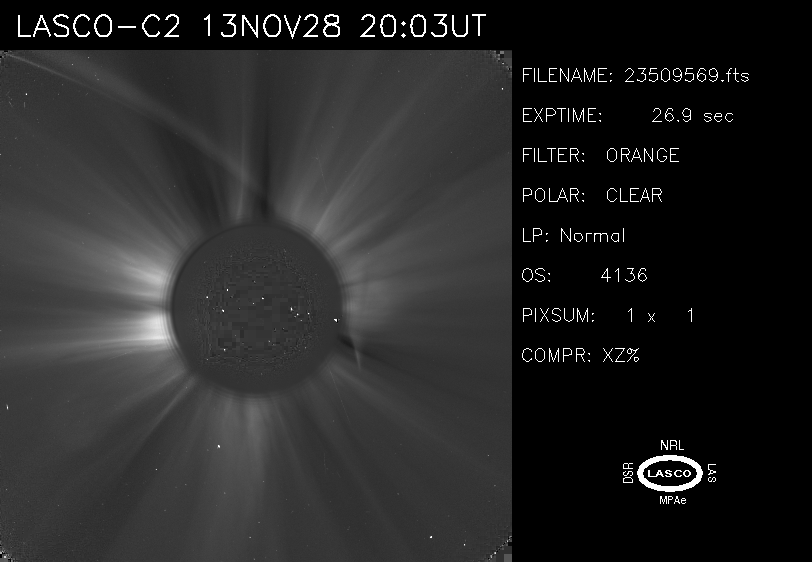
This real-time data from the SOHO/LASCO C2 instrument shows a streak on the right side of the sun, which is due to the leftover debris from Comet ISON’s tail.
This is what we thought we’d see in SDO
This video shows the journey of Comet Lovejoy around the sun as seen by SDO. This is close to what we thought we would see from SDO.
http://youtu.be/fFC2IU-O8M0
Watch the Google+ ISON Hangout replay

Amateur astronomer Waldemar Skorupa captured this picture of ISON from Kahler Asten, Germany (shared by spaceweather.com)
Comet ISON heading into the sun
Updated Nov. 28, 2013 – 11 am EST or 16 UT
For real-time updates on distance and speed go to http://www.cometison2013.co.uk/perihelion-and-distance/
| Size | 1.3 mi in diameter or 2 km in diameter |
| Date and Time of Perihelion | 28 November 2013, 18:38 UT (1:38 EST) |
| Distance from the sun at Perihelion |
1,167,615 mi or 1,877,850 km |
| Speed at Perihelion |
843,500 mph or 1,357,400 kph |
Comet ISON is fast approaching the culmination of its journey towards and hopefully around the sun. On November 28, 2013 at 18:45 UT (1:45 EST) ISON reaches perihelion (closest solar approach) and scientists can’t wait.
Comet ISON (C/2012 S1) is a sungrazing comet that was discovered by Vitali Nevski and Artyom Novichonok on September 21, 2012 using as part of the International Scientific Optical Network (ISON).
Comet ISON Gallery
Comet Encounter on PBS – featuring Dr. C. Alex Young
What is a Sungrazing Comet?
Because ISON is a sungrazing comet it is of immediate interest to solar scientists. But what makes ISON really exciting is that the comet is large enough in size that it has a good chance of surviving its journey past perihelion (closest solar approach). Most sungrazing comets are completely destroyed during the closest approach to the sun. The intense solar radiation, solar wind and huge tidal forces usually spell certain destruction for most sungrazers. In fact, the now famous Comet Lovejoy survived its journey around the sun and scientist captured all of this with several spacecraft normally designed just to look at the sun not comets.
ISON promises to possibiltiy be even more spectacular as it is estimated to be larger than Lovejoy. Simply put is has more stuff and so it has a better chance of surviving its perilous journey near the sun.
As ISON gets closer to the sun it will continue to brighten. More observers on the ground and more missions in space will see the comet as it brightens.
By November 7, 2013, ISON has been observed by 8 different spacecraft including the solar missions, SOHO and STEREO (both STEREO-A and STEREO-B).

Comet #ISON observed by 8 spacecraft and counting! A quick look at the 8, http://bit.ly/1iOXfIr credit: NASA/ESA/ISON campaign
On November 8, 2013 ISON was about 0.8 AU (74 million m, 120 million km) from the sun, traveling 47 km/s (105,000 mph, 169,000 kph), shedding ~16 Olympic-sized pools of water per day. The average coronal mass ejection (CME) is traveling at speeds ~10-20 times faster and is made of ~1 billion tons of stuff, equal to ~ 400,000 Olympic-sized pools of water.
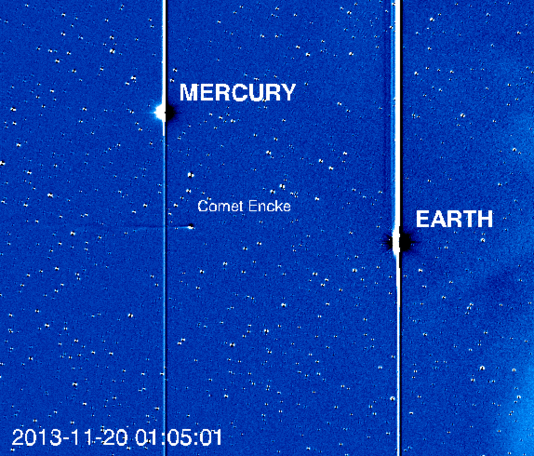
Image Credit: Karl Battams/NASA/STEREO/CIOC
https://www.youtube.com/watch?feature=player_embedded&v=nZi4Ecu_cfY
This movie from the spacecraft’s Heliospheric Imager shows Comet ISON, Mercury, Comet Encke andEarth over a five-day period from Nov. 20 to Nov. 25, 2013. The sun sits right of the field of view of this camera.
Image Credit: NASA/STEREO
Comet ISON on the approach to the Sun. It entered the SOHO LASCO C3 field of view at 01:41 UT on 27 November. This video covers over 24 hours of the journey so far. CREDIT: ESA/NASA SOHO satellite
How NASA Space Assets Will Observe Comet ISON
The main solar missions that are and will be observing ISON as it makes its journey around the sun are the SOHO, STEREO and SDO missions. These missions have all coordinated their observations to get the best possible data of the comet possible. The NASA Comet ISON Observing Campaign has outlined the basic plan on their website. In addition the STEREO team has outlined their plans for the SOHO and STEREO observations on their site. The SDO team on their external blog and on the Know Your Night Sky site. SDO also has a site dedicated to the near-realtime data they plan to receive.
NASA has quite space fleet tracking ISON:
| Solar Dynamics Observatory | Observing ISON under extreme-ultraviolet light when the comet is closest to the sun. |
| SOHO | Observing ISON as it passes by the sun in late November. |
| STEREO | Observing ISON as it passes by on its way to sun in late November. |
| MESSENGER | Observing ISON as it passes by Mercury on November 19th on its way to the sun. |
| BRRISON | Sub-orbital balloon that will be launched mid September to study ISON from above nearly all of the Earth’s atmosphere. |
| FORTIS | Sounding rocket that will be launched in mid-to-late November to obtain ultra-violet spectra from ISON. |
| Hubble Space Telescope | Observed ISON in April-May and will see it again in October and December (if ISON survives). |
| Spitzer Space Telescope | Observed ISON on June 13. The comet was 310 million miles away from the sun. |
| Chandra X-ray Observatory | Observing ISON’s interactions with the solar wind. |
| International Space Station | Astronauts will be able to observe Comet ISON as it passes by the sun in late November. |
| Lunar Reconnaissance Orbiter | Observing ISON as it passes by the moon in late November. |
| Swift | In January and March, Swift observed ISON when it was 460 million miles away from the sun. |
| Curiosity | Observing ISON as it passes by Mars. Closest approach is October 1st. |
| Opportunity | Observing ISON as it passes by Mars on its way to the sun on 1 October. |
| Mars Reconnaissance Orbiter | Observing ISON as it passes by Mars. Closest approach is October 1st. |
| Deep Impact | Imaged ISON for the first time on January 17 and 18 from 493 million miles away. |
Ground-Based Observers
| Amateur Astronomer | You – with a telescope or binoculars in November. |
| Research Telescopes | NASA Infrared Telescope Facility, Keck Observatory and many more. |
What will SDO see?
There’s also a possibility that the Solar Dynamics Observatory (SDO) satellite might be able to observe Comet ISON in extreme-ultraviolet when it’s closest to the Sun. However, at the currently estimated apparent distance of 1.8 solar radii, SDO would have to point away from the Sun to see the comet. In order to make these observations possible the SDO team has develop a detailed plan to point the spacecraft away from sun centered pointing. The “off-pointing” of SDO will take place in 3 stages. There is one pointing for ION’s approach, one during perihelion and one for its departure. Below is a diagram showing the predicted orbit of ISON as it passes the sun. Boxes mark the 3 different fields-of-view of SDO as it moves to follow the comet’s path. Each time the spacecraft moves to a new pointing there is a short period needed for the spacecraft to settle to minimize movement of the camera. There is also an animation of the observation plan. It shows the pointing and field-of-view for SDO as ISON passes the sun. For more about SDO check out their external blog and the Know Your Night Sky site.
What will STEREO see?
STEREO and SOHO are expected to provide extensive coverage of ISON’s trip near the sun. The STEREO team has created a great set of images showing ISON’s predicted position before, during and after perihelion for the two STEREO spacecraft and the SOHO spacecraft. Here are the main predicted observations but the STEREO page provides a much more detailed discussion of what STEREO and SOHO should see. In addition to these images, the STEREO page has 2 different tools to look at ISON’s orbit.
Leading up to the Big Day
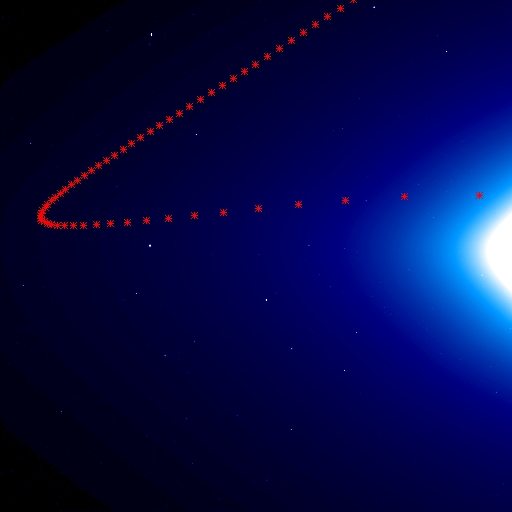
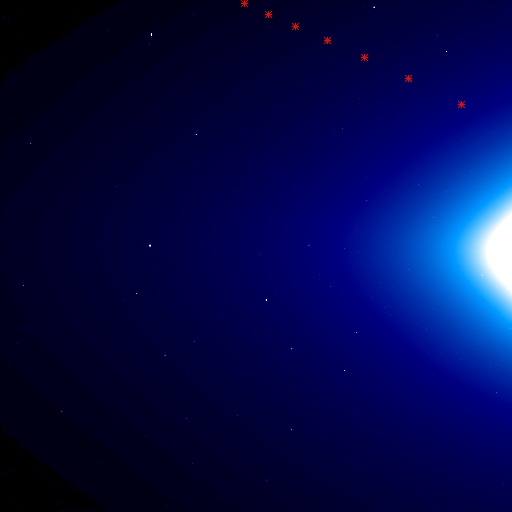
Around and Near Perihelion
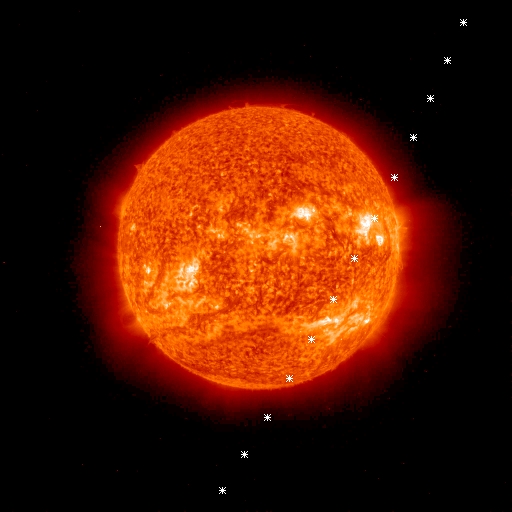
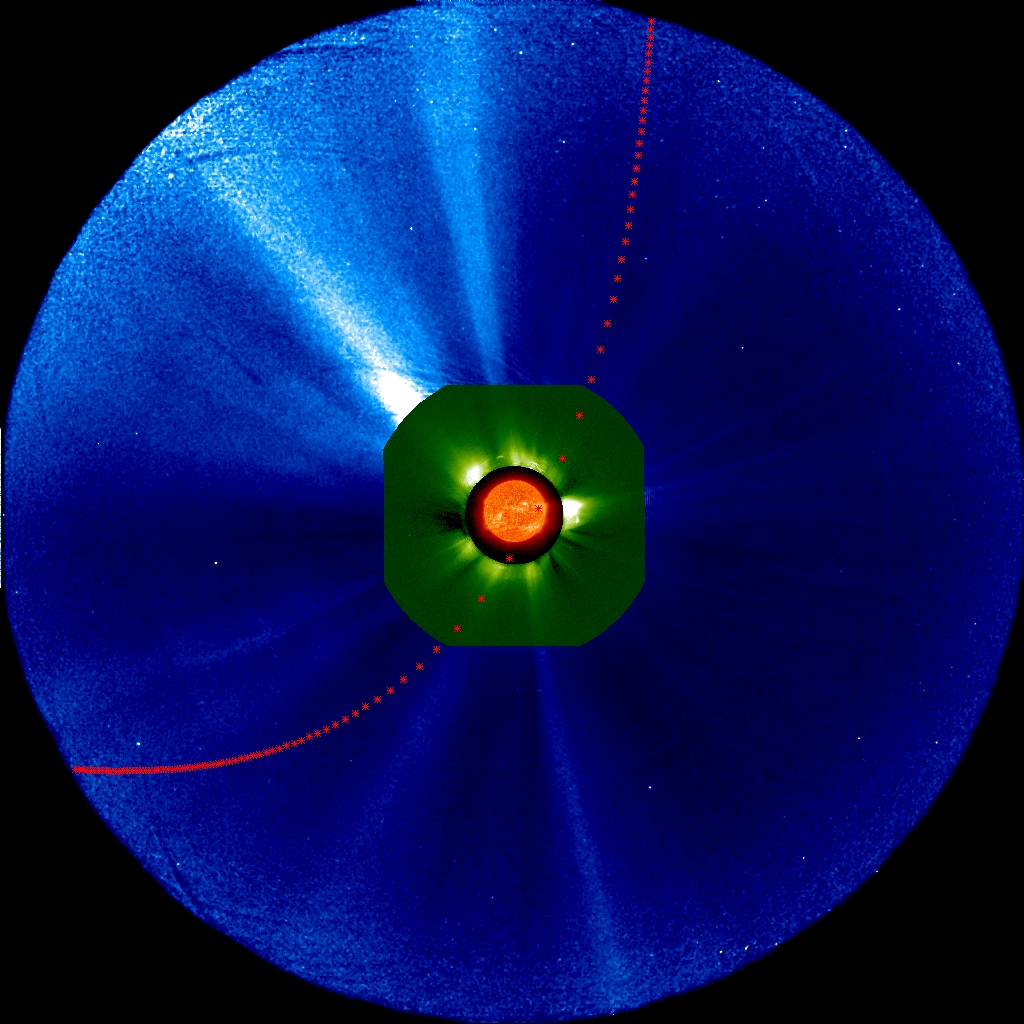
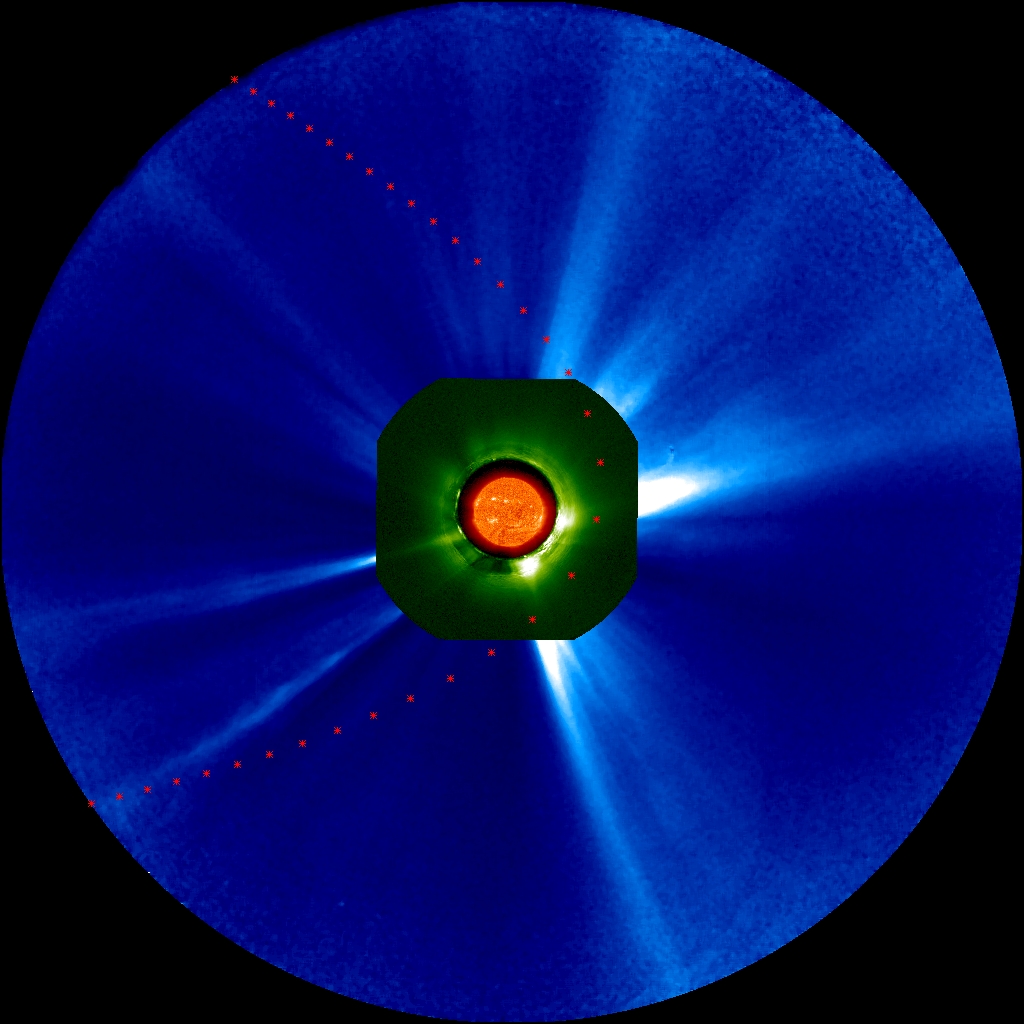
After Perihelion
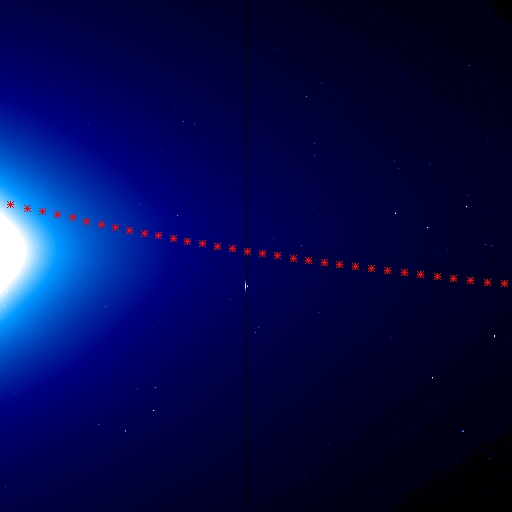
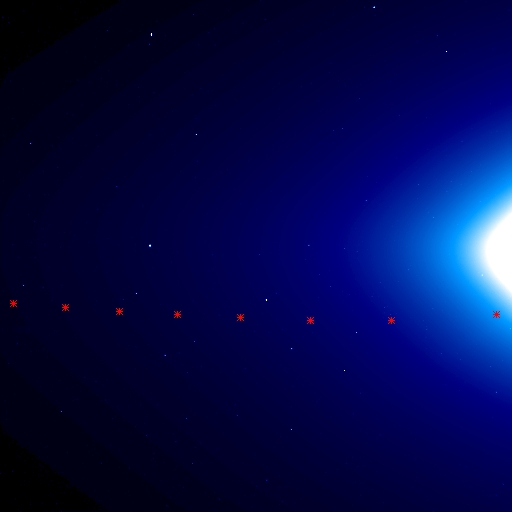
What will SOHO see?
The LASCO C2 and C3 coronagraphs on the Solar and Heliospheric Observatory (SOHO) satellite will also have a view of the comet as it passes through their fields-of-view, as shown below. From SOHO’s viewpoint the comet enters from the lower right early on November 27 and exits towards the top near the end of November 30.

Predicted hour-by-hour position of Comet ISON in the LASCO C3 (blue) and C2 (red) fields-of-view on SOHO, November 27-30, 2013. (credit: NASA/STEREO/SOHO)
Help spread the word with social media images!
More Resources for ISON
Below are listed some of the main great resources to follow all the aspects of Comet ISON. Also, The Sun Today’s Alex Young will be at the SDO Mission Operations Center on the day of perihelion to broadcast the event live via a special NASA sponsored Google+ Hangout. Stay tuned for more details as they become available.


